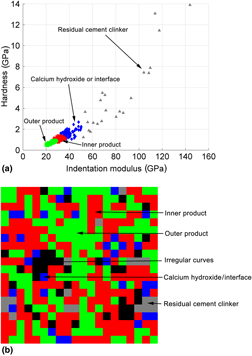Crossref Citations
This article has been cited by the following publications. This list is generated based on data provided by
Crossref.
Hu, Chuanlin
and
Li, Zongjin
2015.
A review on the mechanical properties of cement-based materials measured by nanoindentation.
Construction and Building Materials,
Vol. 90,
Issue. ,
p.
80.
Hu, Chuanlin
Gao, Yueyi
Zhang, Yamei
and
Li, Zongjin
2016.
Statistical nanoindentation technique in application to hardened cement pastes: Influences of material microstructure and analysis method.
Construction and Building Materials,
Vol. 113,
Issue. ,
p.
306.
Thomas, R.J.
Gebregziabiher, Berhan Seium
Giffin, Adom
and
Peethamparan, Sulapha
2018.
Micromechanical properties of alkali-activated slag cement binders.
Cement and Concrete Composites,
Vol. 90,
Issue. ,
p.
241.
Silva, Abílio P.
Booth, Fernando
Garrido, Liliana
Aglietti, Esteban
Pena, Pilar
and
Baudín, Carmen
2018.
Young’s modulus and hardness of multiphase CaZrO3-MgO ceramics by micro and nanoindentation.
Journal of the European Ceramic Society,
Vol. 38,
Issue. 4,
p.
2194.
Gao, Yueyi
Hu, Chuanlin
Zhang, Yamei
Li, Zongjin
and
Pan, Jinlong
2018.
Investigation on microstructure and microstructural elastic properties of mortar incorporating fly ash.
Cement and Concrete Composites,
Vol. 86,
Issue. ,
p.
315.
Koumoulos, Elias P.
Paraskevoudis, Konstantinos
and
Charitidis, Costas A.
2019.
Constituents Phase Reconstruction through Applied Machine Learning in Nanoindentation Mapping Data of Mortar Surface.
Journal of Composites Science,
Vol. 3,
Issue. 3,
p.
63.
Shen, Peiliang
Lu, Linnu
He, Yongjia
Wang, Fazhou
and
Hu, Shuguang
2019.
The effect of curing regimes on the mechanical properties, nano-mechanical properties and microstructure of ultra-high performance concrete.
Cement and Concrete Research,
Vol. 118,
Issue. ,
p.
1.
Gautham, S.
and
Sasmal, Saptarshi
2019.
Recent Advances in Evaluation of intrinsic mechanical properties of cementitious composites using nanoindentation technique.
Construction and Building Materials,
Vol. 223,
Issue. ,
p.
883.
Ford, Emily
Arora, Aashay
Mobasher, Barzin
Hoover, Christian G.
and
Neithalath, Narayanan
2020.
Elucidating the nano-mechanical behavior of multi-component binders for ultra-high performance concrete.
Construction and Building Materials,
Vol. 243,
Issue. ,
p.
118214.
Konstantopoulos, Georgios
Koumoulos, Elias P.
and
Charitidis, Costas A.
2020.
Testing Novel Portland Cement Formulations with Carbon Nanotubes and Intrinsic Properties Revelation: Nanoindentation Analysis with Machine Learning on Microstructure Identification.
Nanomaterials,
Vol. 10,
Issue. 4,
p.
645.
Ouyang, Xue
Shi, Caijun
Wu, Zemei
Li, Kai
Shan, Bo
and
Shi, Jinhua
2020.
Experimental investigation and prediction of elastic modulus of ultra-high performance concrete (UHPC) based on its composition.
Cement and Concrete Research,
Vol. 138,
Issue. ,
p.
106241.
Liu, Jiahan
Zeng, Qiang
and
Xu, Shilang
2020.
Is scratch test proper to characterize microstructure and mechanical properties of cement-based materials? The effects of loading level and routine.
Cement and Concrete Research,
Vol. 133,
Issue. ,
p.
106072.
Badiee, Hassan
Sabermahani, Mohsen
Javadi, Armin Saeedi
and
Bouazza, Abdelmalek
2021.
Comparison of Microbially Induced Carbonate Precipitation with Ordinary Portland Cement Producing Macroporous Pervious Concrete.
Journal of Materials in Civil Engineering,
Vol. 33,
Issue. 5,
Žižka, Radovan
Čtvrtlík, Radim
Tomáštík, Jan
Fačevicová, Kamila
Vencálek, Ondřej
Šedý, Jiří
and
Marinčák, David
2021.
Assessment of Mineral Trioxide Aggregate Setting in Simulated Root Canal with Different Root Canal Wall Thickness: In Vitro Study.
Applied Sciences,
Vol. 11,
Issue. 4,
p.
1727.
Chen, Xiaowen
Hou, Dongwei
Han, Yudong
Ding, Xiaoping
and
Hua, Peicheng
2021.
Clustering analysis of grid nanoindentation data for cementitious materials.
Journal of Materials Science,
Vol. 56,
Issue. 21,
p.
12238.
Homel, Michael A.
Iyer, Jaisree
Semnani, Shabnam J.
and
Herbold, Eric B.
2022.
Mesoscale model and X-ray computed micro-tomographic imaging of damage progression in ultra-high-performance concrete.
Cement and Concrete Research,
Vol. 157,
Issue. ,
p.
106799.
Caron, Richard
Patel, Ravi A.
Bogner, Andreas
and
Dehn, Frank
2022.
Multi-Scale Experimental Investigation and Analytical Micro-Mechanical Modeling to Determine the Elastic Properties of Alkali Activated Concrete.
SSRN Electronic Journal ,
Li, Siyue
Ren, Jing
Kasyap, Sathwik S.
and
Senetakis, Kostas
2022.
Mechanical, micro-structure and contour mapping analyses of highly-porous intermediate-texture analog rock from instrumented micro-indentation in conjunction with statistical/machine learning tools.
Geomechanics and Geophysics for Geo-Energy and Geo-Resources,
Vol. 8,
Issue. 3,
Xie, Ruifeng
and
Tang, Baixiao
2022.
Influence of surface roughness on concrete nanoindentation.
European Journal of Environmental and Civil Engineering,
Vol. 26,
Issue. 9,
p.
3818.
Yin, Hang
Wang, Xuefeng
Qin, Haifeng
Wang, Shijie
and
Cai, Kun
2023.
Nanoindentation Study of Calcium-Silicate-Hydrate Gel via Molecular Dynamics Simulations.
Nanomaterials,
Vol. 13,
Issue. 18,
p.
2578.
